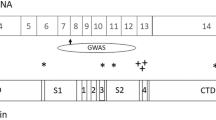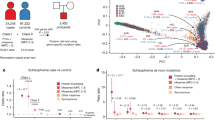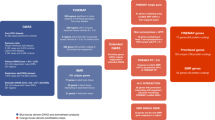Abstract
Dysfunction of the N-methyl-D-aspartate (NMDA) receptors has been implicated in the etiology of schizophrenia based on psychotomimetic properties of several antagonists and on observation of genetic animal models. To conduct association analysis of the NMDA receptors in the Chinese population, we examined 16 reported SNPs across the NMDA receptor NR1 subunit gene (GRIN1) and NR2B subunit gene (GRIN2B), five of which were identified in the Chinese population. In this study, we combined universal DNA microarray and ligase detection reaction (LDR) for the purposes of association analysis, an approach we considered to be highly specific as well as offering a potentially high throughput of SNP genotyping. The association study was performed using 253 Chinese patients with schizophrenia and 140 Chinese control subjects. No significant frequency differences were found in the analysis of the alleles but some were found in the haplotypes of the GRIN2B gene. The interactions between the GRIN1 and GRIN2B genes were evaluated using the multifactor-dimensionality reduction (MDR) method, which showed a significant genetic interaction between the G1001C in the GRIN1 gene and the T4197C and T5988C polymorphisms in the GRIN2B gene. These findings suggest that the combined effects of the polymorphisms in the GRIN1 and GRIN2B genes might be involved in the etiology of schizophrenia.
Similar content being viewed by others
Log in or create a free account to read this content
Gain free access to this article, as well as selected content from this journal and more on nature.com
or
References
Hollmann M, Heinemann S : Cloned glutamate receptors. Annu Rev Neurosci 1994; 17: 31–108.
Nakanishi S, Masu M : Molecular diversity and functions of glutamate receptors. Annu Rev Biophys Biomol Struct 1994; 23: 319–348.
Moriyoshi K, Masu M, Ishii T, Shigemoto R, Mizuno N, Nakanishi S : Molecular cloning and characterization of the rat NMDA receptor. Nature 1991; 354: 31–37.
Luby ED, Cohen BD, Rosenbaum G, Gottlieb JS, Kelley R : Study of a new schizophrenomimetic drug; sernyl. AMA Arch Neurol Psychiatry 1959; 81: 363–369.
Javitt DC, Zukin SR : Recent advances in the phencyclidine model of schizophrenia. Am J Psychiatry 1991; 148: 1301–1308.
Ellison G : The N-methyl-D-aspartate antagonists phencyclidine, ketamine and dizocilpine as both behavioral and anatomical models of the dementias. Brain Res Brain Res Rev 1995; 20: 250–267.
Malhotra AK, Pinals DA, Adler CM et al: Ketamine-induced exacerbation of psychotic symptoms and cognitive impairment in neuroleptic-free schizophrenics. Neuropsychopharmacology 1997; 17: 141–150.
Abi-Saab WM, D'Souza DC, Moghaddam B, Krystal JH : The NMDA antagonist model for schizophrenia: promise and pitfalls. Pharmacopsychiatry 1998; 31 (Suppl 2): 104–109.
Li Y, Erzurumlu RS, Chen C, Jhaveri S, Tonegawa S : Whisker-related neuronal patterns fail to develop in the trigeminal brainstem nuclei of NMDAR1 knockout mice. Cell 1994; 76: 427–437.
Forrest D, Yuzaki M, Soares HD et al: Targeted disruption of NMDA receptor 1 gene abolishes NMDA response and results in neonatal death. Neuron 1994; 13: 325–338.
Ikeda K, Araki K, Takayama C et al: Reduced spontaneous activity of mice defective in the epsilon 4 subunit of the NMDA receptor channel. Brain Res Mol Brain Res 1995; 33: 61–71.
Sakimura K, Kutsuwada T, Ito I et al: Reduced hippocampal LTP and spatial learning in mice lacking NMDA receptor epsilon 1 subunit. Nature 1995; 373: 151–155.
Ebralidze AK, Rossi DJ, Tonegawa S, Slater NT : Modification of NMDA receptor channels and synaptic transmission by targeted disruption of the NR2C gene. J Neurosci 1996; 16: 5014–5025.
Kutsuwada T, Sakimura K, Manabe T et al: Impairment of suckling response, trigeminal neuronal pattern formation, and hippocampal LTD in NMDA receptor epsilon 2 subunit mutant mice. Neuron 1996; 16: 333–344.
Das S, Sasaki YF, Rothe T et al: Increased NMDA current and spine density in mice lacking the NMDA receptor subunit NR3A. Nature 1998; 393: 377–381.
Williams NM, Bowen T, Spurlock G et al: Determination of the genomic structure and mutation screening in schizophrenic individuals for five subunits of the N-methyl-D-aspartate glutamate receptor. Mol Psychiatry 2002; 7: 508–514.
Sakurai K, Toru M, Yamakawa-Kobayashi K, Arinami T : Mutation analysis of the N-methyl-D-aspartate receptor NR1 subunit gene (GRIN1) in schizophrenia. Neurosci Lett 2000; 296: 168–170.
Ohtsuki T, Sakurai K, Dou H, Toru M, Yamakawa-Kobayashi K, Arinami T : Mutation analysis of the NMDAR2B (GRIN2B) gene in schizophrenia. Mol Psychiatry 2001; 6: 211–216.
Begni S, Moraschi S, Bignotti S et al: Association between the G1001C polymorphism in the GRIN1 gene promoter region and schizophrenia. Biol Psychiatry 2003; 53: 617–619.
Rice SR, Niu N, Berman DB, Heston LL, Sobell JL : Identification of single nucleotide polymorphisms (SNPs) and other sequence changes and estimation of nucleotide diversity in coding and flanking regions of the NMDAR1 receptor gene in schizophrenic patients. Mol Psychiatry 2001; 6: 274–284.
Tani A, Kikuta R, Itoh K et al: Polymorphism analysis of the upstream region of the human N-methyl-D-aspartate receptor subunit NR1 gene (GRIN1): implications for schizophrenia. Schizophr Res 2002; 58: 83–86.
Martucci L, Wong AH, Trakalo J et al: N-methyl-D-aspartate receptor NR1 subunit gene (GRIN1) in schizophrenia: TDT and case-control analyses. Am J Med Genet 2003; 119B: 24–27.
Hung CC, Chen HY, Chen CH : Systematic mutation analysis of the human glutamate receptor, ionotropic, N-methyl-D-aspartate 1 gene(GRIN1) in schizophrenic patients. Psychiatr Genet 2002; 12: 225–230.
Moore JH : The ubiquitous nature of epistasis in determining susceptibility to common human diseases. Hum Hered 2003; 56: 73–82.
Pastinen T, Kurg A, Metspalu A, Peltonen L, Syvanen AC : Minisequencing: a specific tool for DNA analysis and diagnostics on oligonucleotide arrays. Genome Res 1997; 7: 606–614.
Southern EM, Maskos U, Elder JK : Analyzing and comparing nucleic acid sequences by hybridization to arrays of oligonucleotides: evaluation using experimental models. Genomics 1992; 13: 1008–1017.
Gunderson KL, Huang XC, Morris MS, Lipshutz RJ, Lockhart DJ, Chee MS : Mutation detection by ligation to complete n-mer DNA arrays. Genome Res 1998; 8: 1142–1153.
Erdogan F, Kirchner R, Mann W, Ropers HH, Nuber UA : Detection of mitochondrial single nucleotide polymorphisms using a primer elongation reaction on oligonucleotide microarrays. Nucleic Acids Res 2001; 29: E36.
Gerry NP, Witowski NE, Day J, Hammer RP, Barany G, Barany F : Universal DNA microarray method for multiplex detection of low abundance point mutations. J Mol Biol 1999; 292: 251–262.
Consolandi C, Busti E, Pera C et al: Detection of HLA polymorphisms by ligase detection reaction and a universal array format: a pilot study for low resolution genotyping. Hum Immunol 2003; 64: 168–178.
Favis R, Day JP, Gerry NP, Phelan C, Narod S, Barany F : Universal DNA array detection of small insertions and deletions in BRCA1 and BRCA2. Nat Biotechnol 2000; 18: 561–564.
Busti E, Bordoni R, Castiglioni B et al: Bacterial discrimination by means of a universal array approach mediated by LDR (ligase detection reaction). BMC Microbiol 2002; 2: 27.
Guo Z, Guilfoyle RA, Thiel AJ, Wang R, Smith LM : Direct fluorescence analysis of genetic polymorphisms by hybridization with oligonucleotide arrays on glass supports. Nucleic Acids Res 1994; 22: 5456–5465.
Ritchie MD, Hahn LW, Roodi N et al: Multifactor-dimensionality reduction reveals high-order interactions among estrogen-metabolism genes in sporadic breast cancer. Am J Hum Genet 2001; 69: 138–147.
Hahn LW, Ritchie MD, Moore JH : Multifactor dimensionality reduction software for detecting gene-gene and gene-environment interactions. Bioinformatics 2003; 19: 376–382.
Ritchie MD, Hahn LW, Moore JH : Power of multifactor dimensionality reduction for detecting gene–gene interactions in the presence of genotyping error, missing data, phenocopy, and genetic heterogeneity. Genet Epidemiol 2003; 24: 150–157.
Beier M, Hoheisel JD : Versatile derivatisation of solid support media for covalent bonding on DNA-microchips. Nucleic Acids Res 1999; 27: 1970–1977.
Jorde LB : Linkage disequilibrium and the search for complex disease genes. Genome Res 2000; 10: 1435–1444.
Sham PC, Curtis D : Monte Carlo tests for associations between disease and alleles at highly polymorphic loci. Ann Hum Genet 1995; 59 (Part 1): 97–105.
Cho YM, Ritchie MD, Moore JH et al: Multifactor-dimensionality reduction shows a two-locus interaction associated with Type 2 diabetes mellitus. Diabetologia 2004; 47: 549–554.
Xu Q, Jia YB, Zhang BY et al: Association study of an SNP combination pattern in the dopaminergic pathway in paranoid schizophrenia: a novel strategy for complex disorders. Mol Psychiatry 2004; 9: 510–521.
Carrasquillo MM, McCallion AS, Puffenberger EG, Kashuk CS, Nouri N, Chakravarti A : Genome-wide association study and mouse model identify interaction between RET and EDNRB pathways in Hirschsprung disease. Nat Genet 2002; 32: 237–244.
Moore JH, Williams SM : New strategies for identifying gene–gene interactions in hypertension. Ann Med 2002; 34: 88–95.
Tsai CT, Lai LP, Lin JL et al: Renin–angiotensin system gene polymorphisms and atrial fibrillation. Circulation 2004; 109: 1640–1646.
Acknowledgements
This work was supported by grants from the national 973 and 863 programs, the National Natural Science Foundation of China, the Shanghai Municipal Commission for Science and Technology, and the Key Project of the Ministry of Education (No. 03066). We are grateful to the Office of Technology Transfer & Enterprise Development of the Vanderbilt University for providing the MDR software and to Dr Lance W Hahn for helpful discussion.
Author information
Authors and Affiliations
Corresponding author
Additional information
Supplementary Information accompanies the paper on European Journal of Human Genetics website (http://www.nature.com/ejhg)
Supplementary information
Rights and permissions
About this article
Cite this article
Qin, S., Zhao, X., Pan, Y. et al. An association study of the N-methyl-D-aspartate receptor NR1 subunit gene (GRIN1) and NR2B subunit gene (GRIN2B) in schizophrenia with universal DNA microarray. Eur J Hum Genet 13, 807–814 (2005). https://doi.org/10.1038/sj.ejhg.5201418
Received:
Revised:
Accepted:
Published:
Issue date:
DOI: https://doi.org/10.1038/sj.ejhg.5201418
Keywords
This article is cited by
-
Epigenetic regulation of human-specific gene expression in the prefrontal cortex
BMC Biology (2023)
-
Connectivity Analyses of Bioenergetic Changes in Schizophrenia: Identification of Novel Treatments
Molecular Neurobiology (2019)
-
Combined study of genetic and epigenetic biomarker risperidone treatment efficacy in Chinese Han schizophrenia patients
Translational Psychiatry (2017)
-
Association of the GRIN2B Gene Polymorphism with Verbal Fluency and Impairments to Abstract Thought in Schizophrenia
Neuroscience and Behavioral Physiology (2017)
-
Association studies of genomic variants with treatment response to risperidone, clozapine, quetiapine and chlorpromazine in the Chinese Han population
The Pharmacogenomics Journal (2016)



